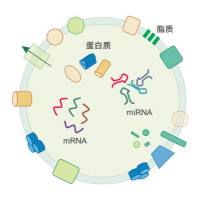白血病干细胞最新研究成果
互联网
4月6日,国际著名学术期刊《血液》在线发表了中国科学院上海生命科学研究院/上海交通大学医学院健康科学研究所发育与疾病实验室及瑞金医院医学基因组学国家重点实验室的最新研究发现:进化上高度保守的PTEN-C/EBPa-CTNNA1信号轴控制造血干细胞发育与白血病干细胞恶性转化。
该实验室前期研究表明CTNNA1基因(编码alpha-catenin蛋白)在正常造血干细胞表达,但在伴有5号染色体长臂缺失的骨髓增生异常综合症和急性髓系白血病患者的白血病干细胞(或白血病起始细胞)中表达水平显著降低。初步证据表明CTNNA1基因是一个潜在的白血病干细胞肿瘤抑制基因,其一个等位基因通过基因组片段缺失而失活,另外一个等位基因被表观遗传学机制(DNA甲基化和组蛋白去乙酰化)抑制。因为DNA甲基化酶抑制剂和组蛋白去乙酰化酶抑制剂在临床上治疗效果有限,因而进一步寻找CTNNA1失活的表观遗传学机制和上游信号调节路径对于在白血病干细胞中重新开启此基因,因而特异性靶向治疗白血病肿瘤干细胞而不影响正常造血干细胞,具有重要的基础和临床意义。
在健康所刘廷析研究员指导下,通过和美国Loyola大学张吉旺教授及瑞金医院诸江教授合作,傅春堂和朱康勇等研究人员发现PTEN-mTOR信号通路作用在PTEN-C/EBPa-CTNNA1轴的上游,在翻译水平决定野生型p42C/EBPa与其显性负p30C/EBPa的比例:mTOR活性增加导致p42C/EBPa/p30C/EBPa比例下降;mTOR活性减低导致p42C/EBPa/p30C/EBPa比例上升。低的p42/p30比例导致p30C/EBPa优先结合到CTNNA1基因的近端启动子元件,并进而招募含EZH2,EED和SUZ12的PRC2蛋白复合体,介导组蛋白H3在第27位赖氨酸残基的三甲基化修饰(H3K27me3)和转录抑制。与此相反,高的p42/p30比例则导致p42C/EBPa结合到CTNNA1基因的近端启动子元件,通过促进H3K4三甲基化(H3K4me3)修饰激活CTNNA1转录。进一步研究发现,在PTEN敲除的小鼠骨髓和Pten敲低的斑马鱼胚胎中,野生型C/EBPa和alpha-catenin蛋白水平均显著下调,同时伴有造血干祖细胞的白血病样增生和异常浸润。更重要的是,该研究发现临床上约20%的髓系白血病患者的白血病干细胞存在CTNNA1低水平表达,而PTEN或CEBPA的移码突变只在这些CTNNA1表达低的白血病干细胞中被检测。
这项研究揭示三个重要的白血病肿瘤抑制基因共同作用在一个进化上高度保守的信号转导轴中,通过调节表观遗传学机制“三把锁”(组蛋白H3K27甲基化,组蛋白去乙酰化和DNA甲基化)而控制造血干细胞发育与白血病干细胞恶性转化。该白血病干细胞肿瘤抑制轴的发现也为白血病干细胞的靶向治疗(特别是CTNNA1表达低的患者)提供了重要线索。
相关研究目前已申请专利。该项目得到科技部发育与生殖重大科学研究计划,中科院百人计划和国家杰出青年基金及上海市科委的资助。
请点击此处下载原文
An evolutionarily conserved PTEN-C/EBP-CTNNA1 axis controls myeloid development and transformation
Chun-Tang Fu
1
, Kang-Yong Zhu
1
, Jian-Qing Mi
1
, Yuan-Fang Liu
1
, Susan T. Murray
2
, Yan-Fang Fu
1
, Chun-Guang Ren
1
, Zhi-Wei Dong
1
, Yi-Jie Liu
1
, Mei Dong
1
, Yi Jin
1
, Yi Chen
1
, Min Deng
1
, Wu Zhang
1
, Bin Chen
1
, Peter Breslin
3
, Sai-Juan Chen
1
, Zhu Chen
1
, Michael W. Becker
2
, Jiang Zhu
1
, Ji-Wang Zhang
3
and Ting Xi Liu
4
1 Institute of Health Sciences, Shanghai Institutes for Biological Sciences, Graduate School of the Chinese Academy of Sciences, Shanghai, China;
2 Division of Hematology/Oncology, University of Rochester, Rochester, NY, United States;
3 Pathology Department, Oncology Institute, Cardinal Bernardin Cancer Center, Loyola University Medical Center, Maywood, IL, United States;
4 Shanghai Stem Cell Institute, Shanghai Jiao Tong University School of Medicine, Shanghai, China ;
【Abstract】Loss of function of tumor suppressor genes such as PTEN, C/EBPA and CTNNA1 has been found to play essential roles in leukemogenesis. However, whether these genes genetically interact remains unknown. We previously reported that the CTNNA1 gene is expressed at a very low level in the HL-60 cell line and in primary leukemia-initiating cells (LICs) with a 5q deletion. Here, we show that PTEN-mTOR signaling acts upstream to dictate the ratio of wild-type p42 C/EBP to its dominant-negative p30 isoform, which critically determines whether p30 C/EBP (lower p42/p30 ratio) or p42 C/EBP (higher p42/p30 ratio) binds to the proximal promoter of the retained CTNNA1 allele. Binding of p30 C/EBP recruits the PRC2 complex to suppress CTNNA1 transcription through repressive H3K27me3 modification, whereas binding of p42 C/EBP relieves this repression and promotes CTNNA1 expression through activating H3K4me3 modification. Loss of Pten function in mice and zebrafish induces myelodysplasia with abnormal invasiveness of myeloid progenitors accompanied by significant reductions in both wild-type C/EBP and -catenin protein. Importantly, frame-shift mutations in either PTEN or CEBPA were detected exclusively in the primary LICs with low CTNNA1 expression. This study uncovers a novel molecular pathway, PTEN-C/EBP-CTNNA1, which might be therapeutically targeted to eradicate LICs with low CTNNA1 expression.




![十二烷基二甲基(3-磺丙基)氢氧化铵内盐 [用于生化研究],14933-08-5,≥98%,阿拉丁](https://img1.dxycdn.com/p/s14/2024/0619/475/6370229598169633081.jpg!wh200)



